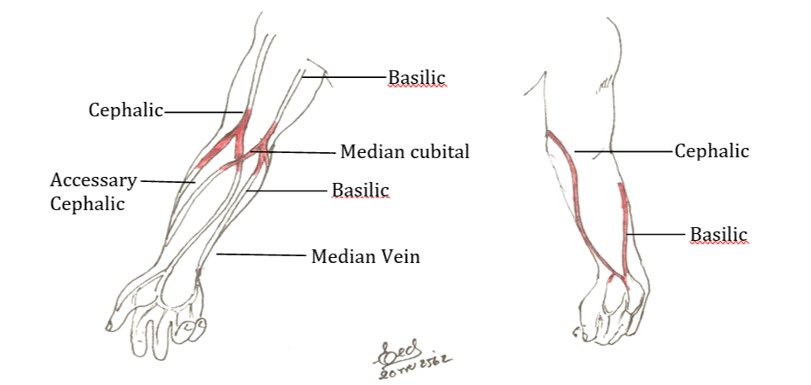Peripheral Venous Cannulation Technique in Cancer Patients
Keywords:
cancer patients, venous cannulation, painAbstract
Cancer pathology interferes physiologic intercellular communication which causes new vascular-structure formation strength defect, distortion and fragile. Such disorder brings about the leakage of plasma, blood corpuscles and fluids into surrounding tissues which causes edema and hypoxemia. Continuous venous chemotherapy treatment on schedule and different kinds of drugs directly affect patients’ blood vessels particularly the perivascular leakage. Therefore, the appropriateness of venous cannulation technique is necessary. Favor location for peripheral venous cannulation is antecubital fossa namely median cubital, cephalic and basilica veins as they are clear to be identified and less adjacent nerves. Moreover, aseptic technique is carried out through procedure. It is important for the operator to take care and pay high attention for the patients after venous cannulation. After the procedure, operators should observe the venipuncture site closely and take precaution of changing the location every 72 hours as well as using the Phlebitis Scale to assess the possibility of phlebitis. In case of problem, the personnel shall make an incidence report, stop all maneuvers and treat affected site with cool or warm sponge. Analgesia becomes the cornerstone of the venipuncture success by probable using local or inhaled anesthetics under pragmatic approach to patients with good relationships.
Downloads
References
Goolsby TV, Lombardo FA. Extravasation of Chemotherapeutic Agents: Prevention and Treatment. Semin Oncol. 2006;33(1):139-143. https://doi.org/10.1053/j.seminoncol.2005.11.007
Svendsen RP, Støvring H, Hansen BL, Kragstrup J, Søndergaard J, Jarbøl DE. Prevalence of cancer alarm symptoms: A population-based cross-sectional study. Scand J Prim Health Care. 2010;28(3):132-137. https://doi.org/10.3109/02813432.2010.505412
Marieb EN, Hoehn K. Human Anatomy & Physiology. 6th ed. Boston: Pearson; 2012.
Gonzalez T. Chemotherapy extravasations: prevention, identification, management, and documentation. Clin J Oncol Nurs. 2013;17(1):61-66. https://doi.org/10.1188/13.CJON.61-66
สุวรรณี สิริเลิศตระกูล. ยารั่วซึมออกนอกหลอดเลือด. สมาคมพยาบาลโรคมะเร็งแห่งประเทศไทย; 2559. http://www.thons.or.th/index.php/knowledge-nurse/29-knowledge-ns-03.
Dougherty L. Extravasation: prevention, recognition and management. Nurs Stand R Coll Nurs G B 1987. 2010;24(52):48-55; quiz 56, 60. https://doi.org/10.7748/ns2010.09.24.52.48.c7956
อรวรรณ อินชูใจ. โครงการการป้องกันการเกิดภาวะExtravasation ในผู้ป่วยมะเร็งที่ได้รับยาเคมีบําบัด. 2553. http://www.hospital.tu.ac.th/km/admin/new/141217_141841.pdf.
ภาวดี ช่วยเจริญ. การเจาะเลือดและการเก็บตัวอย่างเลือด. 2554. http://research-hcu.hcu.ac.th/wp-content/uploads/2015/02/การเจาะเลือดและการเก็บตัวอย่างเลือด.pdf.
วิโรจน์ ไววานิชกิจ, เพียงเพ็ญ อินทรฑูต. ความเจ็บปวดจาการเจาะเลือดและการบริบาลลดความปวด. จุฬาลงกรณ์เวชสาร. 2546;47(8):515-520.
Usichenko TI, Pavlovic D, Foellner S, Wendt M. Reducing Venipuncture Pain by a Cough Trick: A Randomized Crossover Volunteer Study. Anesth Analg. 2004;98(2):343–345. https://doi.org/10.1213/01.ANE.0000094983.16741.AF
Rogers TL, Ostrow CL. The use of EMLA cream to decrease venipuncture pain in children. J Pediatr Nurs. 2004;19(1):33-39. doi:10.1016/j.pedn.2003.09.005
Costello M, Ramundo M, Christopher NC, Powell KR. Ethyl vinyl chloride vapocoolant spray fails to decrease pain associated with intravenous cannulation in children. Clin Pediatr (Phila). 2006;45(7):628-632. https://doi.org/10.1177/0009922806291013
Sealey L. Nurse administration of Entonox to manage pain in ward settings. Nurs Times. 2002;98(46):28-29.

Downloads
Published
How to Cite
Issue
Section
License
บทความที่ได้รับการตีพิมพ์เป็นลิขสิทธิ์ของราชวิทยาลัยจุฬาภรณ์
ข้อความที่ปรากฏในบทความแต่ละเรื่องในวารสารวิชาการเล่มนี้เป็นความคิดเห็นส่วนตัวของผู้เขียนแต่ละท่านไม่เกี่ยวข้องกับราชวิทยาลัยจุฬาภรณ์ และคณาจารย์ท่านอื่น ในราชวิทยาลัยฯ แต่อย่างใด ความรับผิดชอบองค์ประกอบทั้งหมดของบทความแต่ละเรื่องเป็นของผู้เขียนแต่ละท่าน หากมีความผิดพลาดใด ๆ ผู้เขียนแต่ละท่านจะรับผิดชอบบทความของตนเองแต่ผู้เดียว

